On Sunday Emily and I were driving across Pennsylvania when I realized it was time for the Mets game. I started to turn it on, then hesitated. My wife — who’d watched as I turned on Saturday night’s game just in time to see the Mets lose on a play at the plate that their manager saw no reason to challenge — raised an eyebrow and asked me if I really wanted to torture myself.
You know what? I didn’t. I found out later that the Mets had won, said “that’s nice” and got on with my day.
On Tuesday the Mets lost to the Diamondbacks [1]. Neil Walker [2] hit another big home run, but Hansel Robles [3] came in and was jobbed by the ump and then torched by the visitors. The Mets then stopped hitting and that was that.
I know this team remains tantalizingly close to the second wild-card spot, but that says more about a wan wild-card chase then it does about the Mets. Only their record in long-ago April has kept them from sinking completely out of sight; they’ve have been bad since the calendar turned to May, their overall record a slow leak to who knows what miserable level. Their badness is somewhat forgivable, given that they’ve been savaged by injuries, but they’ve also been deeply boring — they’re uninspiring when they win and flat-out unwatchable when they don’t.
If this slow jog in pursuit of being named “second-least-mediocre mediocre National League team” inspires you, well, God bless. I don’t care and I’m no longer interested in pretending that I do.
So I’m going to write about something else instead: the three ballparks I just added to my MLB list, which now stands at 24. They were all a lot of fun to see, and each had some ideas the Mets would do well to emulate. They also had some surprises for me.
 [4]Our first stop was Progressive Field, the home of the Indians. It reminded me a little of Petco, with its white architecture and city view. (Greg’s take from the Jake days is here [5].)
[4]Our first stop was Progressive Field, the home of the Indians. It reminded me a little of Petco, with its white architecture and city view. (Greg’s take from the Jake days is here [5].)
Progressive has good food, kind and attentive folks on duty and is a fine setting for a ballgame. Where it really shines, though, is how it’s meshed the history of team and city. That starts with the statues outside — Larry Doby [6], Bob Feller [7] and Jim Thome [8] greet you — and continues inside. Walking the concourse, you run across features about Cleveland neighborhoods, tributes to players such as Feller and Nap Lajoie, and plaques commemorating great and even just strange moments in Indians history.
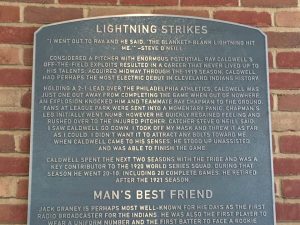 [9]Upstairs there’s a simple, straightforward Indians museum and an Acela Club-style restaurant dedicated to Feller. Emily and I skulked around the latter two before realizing that since this wasn’t Citi Field, the staff was more interested in seeing if we needed anything than in policing where we should or shouldn’t be. (By the way, we only saw the Indians’ unfortunate Chief logo on a couple of t-shirts in an upper-deck store; the team’s clearly slowly phasing it out in favor of a plain red C that’s a likely placeholder for some new stab at a logo.)
[9]Upstairs there’s a simple, straightforward Indians museum and an Acela Club-style restaurant dedicated to Feller. Emily and I skulked around the latter two before realizing that since this wasn’t Citi Field, the staff was more interested in seeing if we needed anything than in policing where we should or shouldn’t be. (By the way, we only saw the Indians’ unfortunate Chief logo on a couple of t-shirts in an upper-deck store; the team’s clearly slowly phasing it out in favor of a plain red C that’s a likely placeholder for some new stab at a logo.)
Another thing we liked about Progressive Field: the A/V folks let the game breathe. You aren’t bombarded with replays, or music, or exhortations to do something. And guess what? The game works perfectly well when that stuff’s delivered in moderation.
What doesn’t work at Progressive Field? The only knock I’ll give is the upper levels are bland and missing the neat touches that make the field level so lively. (This is also the case at Petco.)
From Cleveland we headed for Detroit and Comerica Park, a stadium I’d never thought much about and so approached with few expectations.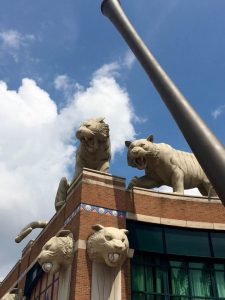 [10]
[10]
Here’s Greg [11] on Tiger Stadium, which he loved; I found myself loving its replacement. Comerica is an architectural gem, exuberantly crowned with tiger heads and Old English D tilework and bats-and-balls friezes — it looks like a revved-up 1930s project, with an army of WPA sculptors told to go bengallistic. Right now it’s still new, but it’ll age beautifully, with fans of the 2060s marveling that someone could have loved tigers that much.
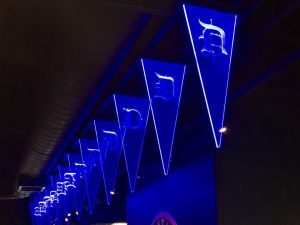 [12]Comerica doesn’t skimp on the details, but revels in them. For instance, the Corner Tap Room, a pub that’s half-in and half-out of the park, celebrates the Tigers’ former homes with exhibits, photos, and little touches such as flags that trace the evolution of the Tigers’ signature D. One side of the bar is labeled Michigan; the perpendicular side says Trumbull. Why can’t Citi Field do that? Rather than McFadden’s, a sterile barn that’s cut off from the park, have the Shea Club and the Polo Grounds as entry points to the new stadium and celebrations of the old ones.
[12]Comerica doesn’t skimp on the details, but revels in them. For instance, the Corner Tap Room, a pub that’s half-in and half-out of the park, celebrates the Tigers’ former homes with exhibits, photos, and little touches such as flags that trace the evolution of the Tigers’ signature D. One side of the bar is labeled Michigan; the perpendicular side says Trumbull. Why can’t Citi Field do that? Rather than McFadden’s, a sterile barn that’s cut off from the park, have the Shea Club and the Polo Grounds as entry points to the new stadium and celebrations of the old ones.
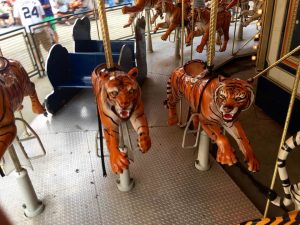 [13]Inside, Comerica continues to exult in its tiger theme — there’s a tiger carousel for kids (of whatever age) to ride, and the various bars feature tigers in different art styles. But the park doesn’t forget its team — each decade of Tigers history gets an exhibit with milestones, replica uniforms and much more besides: you can get a deep dive into franchise history by making a single circuit.
[13]Inside, Comerica continues to exult in its tiger theme — there’s a tiger carousel for kids (of whatever age) to ride, and the various bars feature tigers in different art styles. But the park doesn’t forget its team — each decade of Tigers history gets an exhibit with milestones, replica uniforms and much more besides: you can get a deep dive into franchise history by making a single circuit.
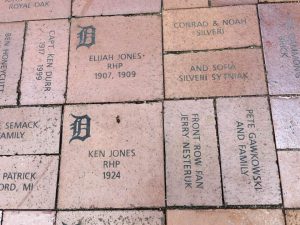 [14]Comerica also zeroes in on a subtle but important idea: that the Tigers and Detroit are deeply interwoven and inextricable. My favorite touch: the Tigers, like the Mets and most modern teams, have a brickwalk with fan messages. But Comerica takes this commonplace theme a smart step further by mixing in bricks for each of the players in franchise history, putting Tigers and Tigers fans together.
[14]Comerica also zeroes in on a subtle but important idea: that the Tigers and Detroit are deeply interwoven and inextricable. My favorite touch: the Tigers, like the Mets and most modern teams, have a brickwalk with fan messages. But Comerica takes this commonplace theme a smart step further by mixing in bricks for each of the players in franchise history, putting Tigers and Tigers fans together.
Comerica’s presentation of the game itself needs a little work; they have an on-field “host” whose ubiquity is irritating. But that’s easy enough to fix, and what surrounds the game is really good. A park I’d never thought about turns out to be one of my favorites.
Our third stop was PNC Park, which I’d been pretty much assured would be either my favorite or runner-up to AT&T. So I was surprised to find that I merely liked it. To be clear, I liked it a lot; it’s just that I didn’t love it. (Greg weighs in here [15].)
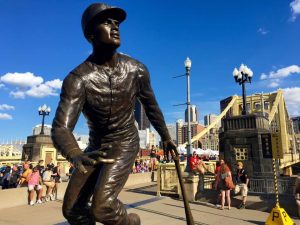 [16]Look, PNC does a lot right. It’s fun to walk in and out across the Roberto Clemente [17] Bridge amid a sea — take the Citi Field stairways in full LET’S GO METS cry and turn that dial to 111. Folks in the park are helpful and attentive without being in your face, and there are interesting quirks that reward exploration. And yes, the setting is undeniably beautiful: the park frames the Pittsburgh skyline perfectly, and it’s fun to stroll along the promenade behind center field overlooking the river.
[16]Look, PNC does a lot right. It’s fun to walk in and out across the Roberto Clemente [17] Bridge amid a sea — take the Citi Field stairways in full LET’S GO METS cry and turn that dial to 111. Folks in the park are helpful and attentive without being in your face, and there are interesting quirks that reward exploration. And yes, the setting is undeniably beautiful: the park frames the Pittsburgh skyline perfectly, and it’s fun to stroll along the promenade behind center field overlooking the river.
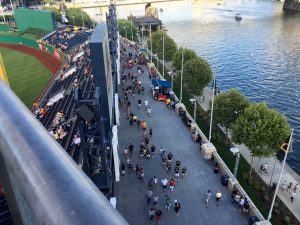 [18]But I’m a little hesitant to award PNC the crown based on its city’s skyline — to borrow a line from recent politics, they didn’t build that. And while it took me a while, I eventually figured out what I felt was lacking about PNC: it doesn’t have enough Pirates in it.
[18]But I’m a little hesitant to award PNC the crown based on its city’s skyline — to borrow a line from recent politics, they didn’t build that. And while it took me a while, I eventually figured out what I felt was lacking about PNC: it doesn’t have enough Pirates in it.
Progressive Field is a valentine to Cleveland neighborhoods and Indians history; Comerica’s got tigers and Tigers competing to come out the wazoo. But PNC struck me as surprisingly lacking in team history — there’s a wan museum of sorts in the restaurant, but few of the exhibits and history lessons and little touches I’d found in Cleveland and Detroit.
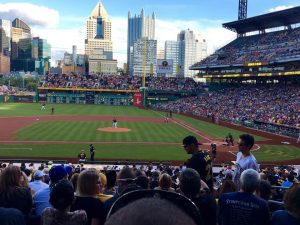 [19]That’s frankly baffling given the team’s rich history and the city’s full-throated love for that team. Why not take a page from Comerica and give fans a goofy, gaudy pirate ship that fires cannons after home runs? Or if that’s too much for you, at least fill the concourses with Piratesiana. Tell me about the nickname’s origins, Bing Crosby, Vern Law [20], the original Kiner’s Korner, Danny Murtaugh [21], “We Are Family,” the Stargell stars, the Cobra, Andy Van Slyke [22], the Killer Bs and so much more. Let me learn about that stuff and revel in it, so that I can moon over the history as much as I do over the prettier-than-a-postcard view.
[19]That’s frankly baffling given the team’s rich history and the city’s full-throated love for that team. Why not take a page from Comerica and give fans a goofy, gaudy pirate ship that fires cannons after home runs? Or if that’s too much for you, at least fill the concourses with Piratesiana. Tell me about the nickname’s origins, Bing Crosby, Vern Law [20], the original Kiner’s Korner, Danny Murtaugh [21], “We Are Family,” the Stargell stars, the Cobra, Andy Van Slyke [22], the Killer Bs and so much more. Let me learn about that stuff and revel in it, so that I can moon over the history as much as I do over the prettier-than-a-postcard view.
(If you like, a full photo gallery [23]‘s over here on my Facebook page.)